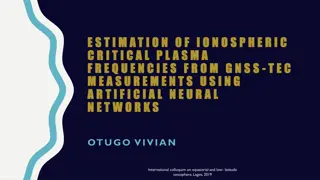BTH/OTH Radar and Maritime Surveillance Radar Overview
The article discusses BTH/OTH radar systems and maritime surveillance radars, exploring their functionalities, benefits, drawbacks, and real-world examples. It delves into the working principles of OTH radar, showcasing how it operates through the ionosphere. Additionally, it covers the concept of m
5 views • 12 slides
Recent Developments in GAMIT/GLOBK for GNSS Processing
Significant updates and future developments in GAMIT/GLOBK for GNSS processing include processing of multiple constellations independently, transition to secure HTTP for code distribution, addition of azimuth field for station alignment, and regular updates schedule. Higher-order ionosphere and rapi
0 views • 10 slides
Understanding Radio Wave Propagation in the Ionosphere
Radio wave propagation in the ionosphere is influenced by factors such as the radio refractive index and absorption of radio wave energy. This chapter delves into the interaction of radio waves with the ionosphere, discussing concepts like the electromagnetic spectrum nomenclature and the frequency
0 views • 15 slides
Understanding High Frequency Radio Communications and ALE
High Frequency (HF) radio communications, specifically using Single Side Band (SSB) modulation, are essential for effective long-distance communication. The components of an HF radio system include a transceiver, antenna, and power source. By utilizing the ionosphere, HF/SSB modulation enables cost-
5 views • 47 slides
Understanding Weak Signal Propagation in Radio Waves
This informative content delves into weak signal propagation and its various aspects related to electromagnetic waves, particularly in the context of radio communication. It covers topics such as radio waves, radio horizon, knife-edge diffraction, tropospheric scatter mode, auroral reflection, and m
1 views • 37 slides
Estimation of Ionospheric Critical Plasma Frequencies Using GNSS Measurements
This research focuses on estimating the critical plasma frequency of the ionosphere, specifically the F2 layer (f0F2), using GNSS measurements. The study reviews past work on ionospheric modeling, discusses neural network training inputs, and presents a single station neural network model (NNT2F2).
0 views • 26 slides
Understanding HF Propagation for Amateur Radio Communication
Dive into the world of HF propagation and how signals travel from one point to another in amateur radio communication. Explore topics such as ionosphere basics, critical frequency, practical examples, and the importance of the F2 layer. Gain insights into launching waves, propagation prediction meth
0 views • 34 slides
Understanding the Layers of the Ionosphere
Explore the layers of the ionosphere including the D, E, Es, and F layers and how they impact radio wave propagation. Discover how solar activity affects ionization levels and skip distances, offering insights into long-distance communication potential. Learn about the influence of solar radiation o
0 views • 19 slides
Cutting-edge Technology at Sodankyl Geophysical Observatory
The Sodankyl Geophysical Observatory in Finland utilizes state-of-the-art technology for ionospheric research, including the Alpha-Wolf sounder, a sophisticated transmitter, and receiver array. The observatory has a rich history of ionosonde operations since 1957, with continuous advancements in dat
2 views • 23 slides
Understanding Ionospheric Absorption Laws and Regions
The principles of the ionosphere at middle and low latitudes, Lambert-Beer exponential absorption law, and characteristics of E and F regions are discussed. The absorption of solar radiation, recombination reactions in different regions, and ionization processes are highlighted, providing insights i
0 views • 15 slides
Recent Insights into Mars Ionosphere Studies with MARSIS-AIS
Discover recent research on the Martian ionosphere conducted by scientists using various instruments such as MARSIS, MAVEN, and MarMCET. Explore studies on electron density profiles, ionospheric traces, and the timing issue correction of the AIS sounding cycle. Publications address improvements in a
0 views • 6 slides
Advancing the Living with a Star Program: Science Goals and Community Priorities
The Living with a Star (LWS) program, led by a dedicated steering committee, aims to provide yearly reports, set long-term visions, and address key science topics in solar and space physics. The community priorities include enabling discovery and addressing societal needs, emphasizing the importance
0 views • 11 slides
Japanese Institutes Implementing SPASE 2.6.0 for Thermosphere/Ionosphere Research
Feedback on implementing SPASE 2.6.0 in the field of Thermosphere/Ionosphere from Japanese institutes including IUGONET. The discussion covers the purpose of the IUGONET project, current status of the metadata databases, the GAIA model, and major scientific results achieved. Input and output data of
0 views • 11 slides
Investigation of Low-Latitude S-Band Ionospheric Scintillations during September 2017 Geo-Magnetic Storm
The study focuses on analyzing the impact of geo-magnetic storms on NAVIC satellites, particularly the S-band signal, during September 2017. Researchers from K.L. Deemed to be University observed variations in solar and geomagnetic activity indices, providing insights into the behavior of the ionosp
0 views • 15 slides
SUNSTORM: Advanced X-ray Technology for Solar Measurements
SUNSTORM, also known as XFM, is a cutting-edge technology designed specifically for measuring X-rays from the Sun, tailored for Space Weather monitoring. It offers high spectral and time resolution, a wide spectral range, and a large dynamic range, making it ideal for various scientific studies rela
0 views • 4 slides
Comparison of MSTID and Sporadic E Distributions in Ionosphere Study
Investigating the role of sporadic E in medium-scale traveling ionospheric disturbances by comparing its distribution with MSTID using CHAMP satellite data. Sporadic E and MSTID occurrences, detection methods, and distribution patterns in different hemispheres are explored, revealing seasonal variat
0 views • 9 slides















